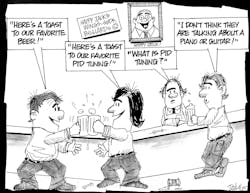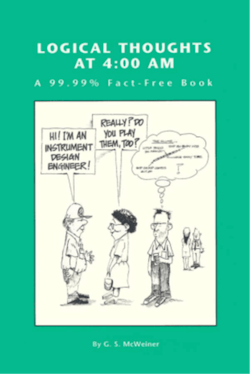What you’ll learn in this article:
- Proper tuning requires understanding process characteristics, including time constants, deadtime, and open-loop gain.
- Load disturbances often originate from process inputs, not outputs. Effective tuning should prioritize disturbance rejection.
- Integrating, runaway and self-regulating processes require different tuning approaches, emphasizing the need for tailored methods.
- Poor tuning can contribute to safety risks, especially in exothermic reactions or pressure control scenarios where slow responses can lead to catastrophic failures.
- What are the best practices for tuning?
- The top 10 ‘uffdas’ you may encounter.
This year I am helping us laugh and possibly learn by making one of my humorous books available to download for free in this year’s first six columns. The fourth book is Logical Thoughts at 4:00 am. Humor can open minds and it can be fun to be silly. People didn’t realize that the knowledge was truthful and G.S. McWeiner was a humorous attempt to combine the authors Greg McMillan and Stan Weiner.
Greg: Now, let’s get serious and attempt to deal with the extreme differences in PID tuning that has led to several hundred different tuning rules. There is controversy and a lack of consensus so the contributors to the ISA-TR5.9-2023 Technical Report “Proportional-Integral-Derivative (PID) Algorithms and Performance” decided against including the topic of controller tuning methods. I am going to take on this considerable task with Michel Taube, principal consultant at S&D Consulting Inc., who offers his perspective on how tuning must improve process operation and safety. I hope we can put our emotions aside and seek some common ground.
I have all of Greg Shinskey’s books and greatly appreciated how he focused on improving PID control to improve process performance by understanding process dynamics. He worked mostly in the time domain, revealing the process response from material and energy balances and evaluating the time response seen on trend charts.
I initially used Bode plots for self-regulating processes and Nyquist plots for integrating and runaway processes to develop equations to estimate the effect of primary process time constant and loop deadtime on ultimate period and ultimate gain. However, I graduated to focus on the time domain. I learned how to write the ordinary differential equations (ODE) for material and energy balances that I could use in dynamic simulations to explore, develop, prototype and test process control improvements (PCI). I appreciate the additional guidance offered by Bode plots for self-regulating processes and the computation of gain margin and phase margin. I rarely see the use of Nyquist plots required for integrating and runaway (positive feedback) processes.
There are some disruptive mistakes. There are PIDs in a few programmable logic controllers (PLCs) and some academic publications that have the PID algorithm working in engineering units instead of percents resulting in more dire consequences. For example, changing flow measurement units for a PID algorithm working in engineer units while keeping the same flow span from a flow rate per second to flow rate per hour requires changing the PID gain settings by a factor of 3,600. The PID algorithm in industry nearly all work in percentages using the specification in engineering units for the measurement, setpoint and output spans in the PID configuration to convert these values to percents.
Some PIDs use the parallel form where the PID gain only affects the proportional mode and an integral gain instead of a reset time and a derivative gain instead of a rate time. Most modern controllers use a standard PID form but older controllers may be hanging on to the series form with a reset setting in repeats per minute. It is critical that you know the PID form and the units of the PID settings before you start tuning. ISA-TR5.9-2023 details the different forms and conversion of tuning settings.
Much of the control literature mistakenly shows disturbances as being on the process output rather than on a process input. This leads to false conclusions that a slow primary process time constant is detrimental and tuning for setpoint response with a low PID gain and little to no rate setting is best. Process output disturbances are rare and are usually associated with a process measurement problem. Process input disturbances from changes in stream flow, composition, temperature and pressure are frequent due to changes in raw materials, recycle streams, catalyst activity, equipment conditions (e.g., fouling) and controller outputs. Many changes in stream composition and equipment conditions are not measured.
The PID algorithm has been proven through applications and by intensive academic study to be the best algorithm for rejecting unmeasured process input disturbances termed load disturbances. More than 70 years of academic work has been wasted on attempts to develop an alternative to the PID algorithm without realizing the rejecting load disturbances better than a well-tuned PID is not real.
Often, literature leads one to believe there is one process time constant. In fact, there are many process time constants due to mixing, mass transfer and heat transfer. In addition, many instrumentation time constants are due to sensor lags, damping settings, signal filters and valve response time. Hopefully, the primary time constant is in the process and large so it slows download disturbances and enables a large PID gain especially when response is computed as near integrating. The ultimate limit to the peak and integrated error is inversely proportional to the primary process time constant. While a large process time constant does slow down a setpoint response, setpoint feedforward and a setpoint lead-lag can significantly help. Also, setpoint changes in primary loops are occasional while load disturbances are frequent.
Another misdirection is the unconditional goal of making a gradual transition to controller output’s final resting value (FRV), which can be an offshoot of thinking the disturbances are on the process output and the process is self-regulating and not dominated by a large process time constant. I saw this touted as essential in a series of articles about five years ago by a well-known consultant. For integrating and runaway processes, the controller output must overshoot its FRV to return to an existing setpoint for a load disturbance or reach a new setpoint.
Also, for pressure and exothermic reactor temperature control, the overshoot needs to be large even approaching an output limit, to provide a fast approach to the setpoint that is safe and efficient. For temperature control, a larger utility flow increases the heat transfer coefficient reducing the utility flow. If the process variable excursion rate is not mitigated by immediate and proactive change in controller output, pressure relief and safety instrumented systems (SIS) are activated. For highly exothermic reactors, the runaway response can reach a point of “no return” when controller output changes are not fast and large enough. I have personally been in a control room when this happened. I was asked to put on a face mask and stay sheltered in place because the reactor temperature had reached a point of “no return” resulting in reactor contents blowing over to a flare stack.
Self-regulating processes with a large time constant are termed “near-integrating” and use tuning rules and settings that provide aggressive FRV overshoot. If there must be some limitation as to the controller output rate of change, up and down rate limits can be configured in configuration to provide directional move suppression, a feature found to be very useful in model predictive control. Simple turning on external reset-feedback (ERFB) eliminates the need to re-tune the PID. Tuning should first be tested without the rate limits. Intelligent directional moves suppression is effectively used to prevent unnecessary crossings of the split range point and prevent the common substantial persistent oscillations caused by large stiction, installed valve characteristic nonlinearity, discontinuity, and transitions in masses and energy as valves try to open and close.
A rate limit is only imposed to slow down a reversal of manipulated valve direction after crossing the split range point. A valve position controller (VPC) is commonly used to optimize operator conditions but they are often tuned to provide very slow action to allow process loops to catch up but this slow action may interfere with correction for fast load disturbances.
Get your subscription to Control's tri-weekly newsletter.
Directional move suppression in VPC can provide a slow approach to a more optimum operating condition and a fast getaway for protection against fast load disturbances. See ISA-TR5.9-2023 for more details on the many advantages offered by ERFB to provide smooth and aggressive changes as needed and to prevent oscillations from slow valves and slow secondary loops.
Often not recognized is the integrated error for load disturbances is proportional to PID reset time and inversely proportional to PID gain setting. The peak error is slightly reduced by a decrease in PID reset time but is more reduced by an increase in PID rate setting and greatly reduced by an increase in PID gain setting. Studies that do not minimize reset setting and maximize gain and rate settings can be misleading. For example, the effect of a proactive significant decrease in measurement deadtime (e.g., decrease in sensor fouling or increase wireless update rate), will not show the benefit until the PID is tuned with a larger PID gain and smaller reset time.
Better tuning rules, procedures, objective and tests
The best strategy is to identify the open-loop dynamics that consists of total loop deadtime, open-loop gain, and primary and possibly secondary time constants. For integrating processes, the open-loop gain is integrating gain and for runaway processes, the primary time constant is a positive feedback time constant. My March article “Fundamentals to better understand process dynamics” helps deal with the many misunderstandings about dynamics often proliferated by conflicting terminology.
Dynamic simulations that include all the process dynamics (e.g., mixing delays, transportation delays, heat and mass transfer lags), valve or variable frequency drive dynamics, measurement location, sensor and transmitter dynamics, and digital control dynamics also able to run faster than real time are an excellent way of getting started. For greenfield projects and runaway processes, it is essential. The inclusion of the dynamic simulation in a digital twin with the actual controller configuration is the best approach.
Why is this article important?
- It addresses critical and often misunderstood aspects of PID tuning, which is essential for effective process control in industrial automation.
- The article debunks several myths, such as the incorrect placement of disturbances in control literature and misunderstandings about process time constants.
- It emphasizes the role of proper PID tuning in preventing hazardous situations, such as runaway reactions, by ensuring controllers respond quickly and effectively to disturbances.
- The discussion on tuning for unmeasured load disturbances and the importance of understanding process dynamics helps improve operational efficiency, reducing errors and energy waste.
- The authors offer real-world experience, including safety incidents, and advocate for a structured approach to PID tuning, considering different process types (self-regulating, integrating, runaway).
- The reference to ISA-TR5.9-2023 provides a framework for engineers and practitioners to align with modern PID control standards.
Now we get to the extremely argumentative stuff about tuning rules. Maybe turn on some of your favorite music, grab some beer, and toast what you have learned and accomplished.
There should be separate tuning rules for self-regulating, integrating, and runaway processes.
Self-regulating process with a primary time constant greater than four times the total loop deadtime are termed near-integrating processes and integrating process tuning rules should be used. Often not realized there is a window of allowable gains for integrating and runaway processes where too low besides too high of a PID gain causes instability. If there are no runaway processes, modified lambda tuning rules are useful that have low limits on reset time to facilitate more proportional action and some derivative action included based on dead time besides secondary time constant. I personally like my Short Cut Method (SCM) based on estimations of the ultimate period and ultimate gain for all three types of processes documented in my book Tuning and Control Loop Performance Fourth Edition free to download.
Tuning for unmeasured load disturbances
Shinskey and I favor first tuning for unmeasured load disturbances. Tuning tests are done by simply putting the controller momentarily in manual, quickly making an output change similar in size to that used to identify the process dynamics and then immediately returning the PID to automatic. There is a tradeoff between performance and robustness, so tests should be done at different operating conditions to confirm that significant oscillations do not develop. Dynamic simulations can readily provide this ability.
Once you have good tuning for rejecting unmeasured load disturbances, setpoint lead-lags or beta and gamma factors in a 2 degrees of freedom (2DOF) PID structure are used to provide a fast approach to setpoint with no significant overshoot. Setpoint feedforward can greatly help, For the fastest approach to setpoint, the controller output can be positioned and held by output tracking at a maximum value until a future value block prediction shows that in slightly more than a dead time, the PV will reach setpoint at which time the output is momentarily set to an estimated FRV and the controller returned to automatic.
Practical applications
Michael, how can we best address some practical application and safety issues?
Michael: First and foremost, in order to properly tune any PID controller, one must understand how the process actually behaves from both the steady state (open-loop gain) as well as dynamic (primary lag time and deadtime) perspectives: a distillation column behaves very differently from a reactor which is different from a compressor; this includes the behavior due to (un)measured disturbances and control element changes, as well as the disturbance and SP change response requirements for the controllers accounting for both safety and nominal operations. Nonlinear (steady state) process behavior is another factor that comes into consideration.
Your comments regarding exothermic reactor controller requirements, as well as your books/articles on pH control, illustrates this point quite clearly. Furthermore, knowing the form of the PID is also required because it affects how the three control terms—proportional, integral and derivative—interact with and affect each other. This understanding is handy when troubleshooting controller behavior. Finally, as you mentioned, one must know whether the control system uses percent-of-scale (PoS) versus engineering units (EU) in its PID calculation. Fortunately, most systems use PoS, but this practical aspect of control implementation is often overlooked in many PID control textbooks and training courses.
The debates around tuning rules ranges from “taste great, less filling” arguments to outright “holy wars.” I’m not going to promote one set of rules over the others. My recommendation is to choose the rules that produce the required response to disturbances and SP changes to satisfy safety and normal operations criteria. Along those lines, there are a few criteria for tuning rules that, I believe, are worth stating:
- The response to both a disturbance rejection and SP change must never cause the PV or the OP to oscillate. For further clarity, “oscillate” for the PV means crossing SP more than once and for OP means crossing the final steady state value more than once during the response time frame. This recommendation is predicated on a single step-change in SP and the same for a hypothetical disturbance.
- Some overshoot of both PV (referenced to SP) and OP (referenced to final steady state value) are fine because it minimizes the error during the initial controller response period. For the OP, it represents the amount of energy the controller injects into the process and that energy will affect the process, so the controller response should be “balanced” appropriately to the process’s behavior.
- In terms of achieving the final steady state values or FRV for both PV and OP, the response should “crisply” get to the final values (taking the above criteria into account) rather than asymptotically approach it (i.e., a long “laggy” approach).
Taking a page from the book on distillation control that I co-authored (A Real-Time Approach to Distillation Process Control, Wiley, 2023), the purpose of Process control is:
To stably, robustly and predictably maintain Product Qualities in the face of Measure and Unmeasured Disturbances with the LEAST total and incremental energy-input (i.e., minimal movement) to the Process while satisfying Operating Constraints and Safety Limits.
The short version can be described as the “Goldilocks Rule”: Not too hot (aggressive), not too cold (sluggish), but just right! And “just right” is entirely dependent upon the specifics of the process behavior, thus it can’t be completely generalized or reduced to a single arbitrary response curve.
I will also add this: I’ve often heard people comment that PID control is not a “model-based” controller. While I understand how this perception came about, it is completely wrong: BOTH the process model (how it really works), the controller response, as well as the PID Form, are imbedded in the tuning constants which are generated from the process characteristics and the intended controller response; thus, even Ziegler-Nichols tuning is “model-based”. This is why PID can address both Integrating as well as Self-Regulating processes without any additional manipulations or “features” (as is required for most multivariable controllers (MVCs)).
As to explicitly limiting output moves with rate-of-change (RoC) or maximum change clamps, I’m averse to implementing or using such features as it can and often does hide or disguise controller behavior and poor/inappropriate tuning. For example, I was engaged with a client and found one controller that had the output RoC clamps so tight that the craziest tuning didn’t change the behavior one bit: the controller hardly moved the output at all. It was only after I stumbled upon the output clamp settings (which were on a different “page” from the tuning constants) that I realized what was (not) happening.
Along these same lines, there is a natural Output limit that results from the mechanical/process design based on the range of the final control elements (FCEs)—usually a flow control valve—relative to the PV it’s intended to control. If the full operating range available from a FCE is based only on steady state considerations and not the controller’s required dynamic behavior into account, particularly for disturbance rejection and/or feed forward control, the FCE could very well be too small. I highly recommend a relative gain analysis (RGA) be performed on all regulatory controllers, both inventory (level and pressure) and quality controls using PoS values, which normalizes them to all to the same basis regardless of EUs. Doing this exercise before the process design is completed will reveal deficient controller and/or mechanical designs which should be addressed before proceeding with the equipment ordering and fabrication. A rule-of-thumb that I’ve described is that any PID controller that has a PoS (normalized) open-loop gain (OLG) or process gain (usually designated as Kp) that is less than 0.2 should be evaluated for a change in mechanical design and/or modifying the manipulated variable-controlled variable (MV-CV) Pairings between controllers in close proximity to each other. Doing so before the equipment is commissioned will save a LOT of grief once the plant is running. A plot of PoS controller gain versus OLG will reveal the reasoning behind this recommendation: to address a 1% change in PV, the controller that has a PoS OLG of 0.2 must make a 6X change in OP at steady state to address that change in PV; as the PoS OLG gets smaller, the controller response gets exponentially larger! And this analysis looks ONLY at the Steady State response: the dynamic response may require a much larger change in Output.
To summarize, there are three things one must understand very clearly and to a high degree of certainty to have a “properly behaving” PID controller:
- Process characteristics: open-loop gain, primary lag time and deadtime (as well as any potential nonlinear steady state behavior);
- PID form; and
- Controller (disturbance and SP change) response requirements
On a related note to your question of “safety issues”, there are a couple of additional comments that are warranted.
One must realize that a SIS is a backstop to address known or expected sources of safety limit excursions. Furthermore, Safety instrument functions (SIFs) are typically designed around single-source failures or excursion sources. It’s impossible to predict a priori all the possible combinations of potential excursion sources (some physical/mechanical, others organizational) that can come together in unanticipated or unexpected ways (e.g., “that can never happen here.”). That’s why I always advocate for controls designs to be visually intuitive to the operator so that when he needs to intervene manually, it’s obvious where and how he needs to do that, as opposed to going behind the curtain to find some esoteric parameter to adjust to prevent the plant from blowing up.
Secondly, from an organizational perspective, both operators and (instrument/mechanical) technicians must be trained in the specific hazards of their processes, so that when they receive a job assignment to repair, diagnose or calibrate something, they understand not only the what (the procedure to follow) but the reason why it—the equipment or instrument--exists; that is, understanding the hazard (to which they ARE potentially exposed) this equipment, SIF or instrument is intended to mitigate. This kind of understanding is what is lacking in so much of the typical safety training that is found throughout the process industries and why we continue to have incidents which are labelled the result of human error.
Greg: “Uffda” is a Scandinavian term I learned since my grandparents are Norwegian. Uffda defies exact translation. It is a heart-rendering expression of feelings at particularly poignant moments. Everybody has had such occasions in their lives. Some days you may feel as though you have had more than your fair share. The following list is dedicated to all of us who have had one or more of those "uffda" days.
Top 10 ‘Uffdas’
- Uffda is a rainstorm in rush hour traffic. A double uffda is a snowstorm at 5 p.m. on Friday.
- Uffda is a new computer program for doing a task that takes five minutes with a pencil. A double uffda is a full day of instruction to explain the new system.
- Uffda is trying to find new words to say the same old things in your goals document for 20 years. A double uffda is a new boss who takes it seriously.
- Uffda is a computer program with its own set of undocumented special function keys. A double uffda is a key template with unrecognizable nomenclature and no exit key.
- Uffda is a deadline for detailed work and a week full of meetings. A double uffda is a meeting for you to explain why the work is not done.
- Uffda is a four percent raise when the inflation rate is five percent and the company has had its best year. A double uffda is the president's bonus of a million.
- Uffda is a computer system that goes haywire and a support person last seen two years ago. A double uffda is a self-service manual pinned to a wall and about to fall due to excessive weight.
- Uffda is a cubicle next to a person who talks to himself. A double uffda is a cubicle next to a person who answers himself.
- Uffda is a cubicle next to a person with a hearing problem. A double uffda is a cubicle next to a project manager with a hearing problem and an impossible schedule.
- Uffda is a pipefitter doing instrument calibration. A double uffda is an operator with channel-locks giving an instrument a whole new look.
About the Author
Greg McMillan
Columnist
Greg K. McMillan captures the wisdom of talented leaders in process control and adds his perspective based on more than 50 years of experience, cartoons by Ted Williams and Top 10 lists.

Leaders relevant to this article:


